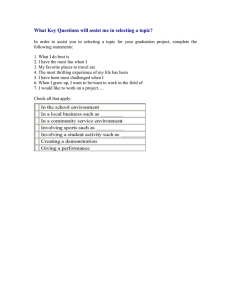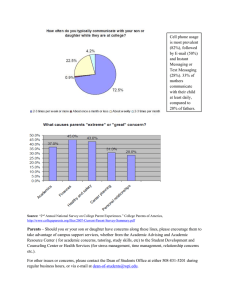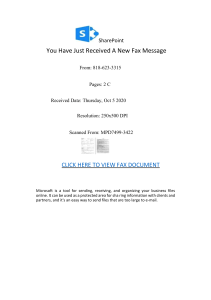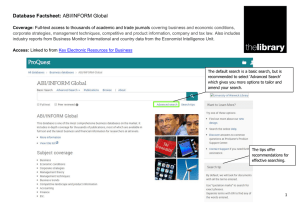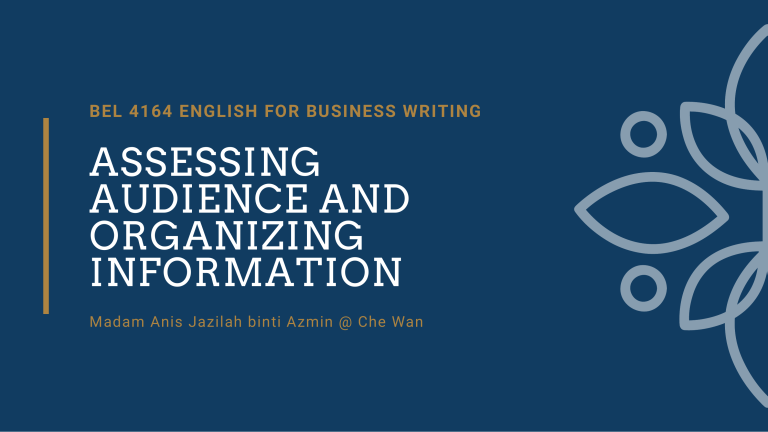
BEL 4164 ENGLISH FOR BUSINESS WRITING ASSESSING AUDIENCE AND ORGANIZING INFORMATION Madam Anis Jazilah binti Azmin @ Che Wan Key Points to Cover 1. WRITING SYSTEMATICALLY A systematic approach helps writers over this hurdle. Before beginning to write, careful writers not only identify their purpose (why they are writing) and audience (to whom they are writing) but also think seriously about the context of their writing (its setting). This process involves first listing all the ideas and facts the writer might include, refining that list by examining each item from the perspectives of audience and purpose, organizing what’s left in a way that satisfies both the writer’s purpose and the audience’s needs, and, finally, deciding on the best medium in which to send it — e-mail, letter, memorandum, or other means. PLANNING YOUR DOCUMENT 1. DETERMNING YOUR PURPOSE Purpose gives direction to your writing. The more precisely you can state your primary purpose at the outset, the more successful your writing is likely to be. To ensure that your purpose is precise, put it in writing. "My primary purpose is to ___________ so that my audience ____________." PLANNING YOUR DOCUMENT 2. ASSESSING YOUR AUDIENCE’S NEEDS PLANNING YOUR DOCUMENT 3. CONSIDERING THE CONTEXT In the workplace, everything is written in a context. The environment, or situation, in which you write a document (such as responding to a customer complaint when the customer was wrong or drafting safety instructions after an accident) will affect how your audience interprets its meaning. Context includes your medium, as well. Are you writing a brochure, a blog entry, Web-site content, or a report? Each is better suited to some audiences and content than the others. PLANNING YOUR DOCUMENT 4. GENERATING, GATHERING, AND RECORDING IDEAS AND FACTS Brainstorming i. Unlock your imagination ii. Think like a journalist iii. Test your ideas Using other sources of information i. Consider to use content created in your organization ii. The internet iii. Library's wealth of books, articles and reference works PLANNING YOUR DOCUMENT 5. ESTABLISHING YOUR SCOPE After refined your list of ideas and facts, you must review it once again to establish the scope of coverage for your topic. Your scope is the degree of detail necessary to cover each item in your list based on your purpose and the needs of your audience. As you think about each item, ask yourself, “How much information should I include to support my purpose and satisfy my audience’s needs?” Often you will find that you have omitted important points or that you need to research your subject further to obtain necessary facts or figures. At other times, you will find that your list is cluttered with unnecessary detail. PLANNING YOUR DOCUMENT 6. ORGANIZING YOUR IDEAS Group the related ideas and arrange them under headings, using short phrases that identify the kind of items in each group. As you group the related ideas, consider the following questions, "Is the time sequence among items important?" If so, organize them chronologically. Do you need to compare the features of one item with those of one or more other items? Organize accordingly. Should you present the most important information first or, instead, build a case that ends with the most important information? In other words, should you organize items by decreasing order of importance or by increasing order of importance? 2. SELECTING MEDIUM With so many media and forms of communication available, selecting the most appropriate medium can be challenging. Which electronic or paper medium is best depends on a wide range of factors, including the following: Audience preferences and expectations The technological resources available How widely information needs to be distributed What kind of record you need to keep The urgency of the communication The sensitivity or confidentiality required The sensitivity or confidentiality required Selecting Medium E-MAIL LETTERS E-mail (or email) functions in the workplace as a primary medium to communi c ate and share electronic files with colleagues, clients, and customers. Business letters are often the most MEMOS Memos are communications among members of the same organization; they use a standard header and are sent on paper or, more often, as attachments to e-mails. appropriate choice for formal communications with professional associates or customers outside an organization. FAXES A fax is used when a drawing or signed contract, for example, must be viewed in its original form. A Selecting Medium INSTANT MESSAGING Instant messaging (IM) on a computer or handheld device may be an efficient way to communicate in real time with coworkers, suppliers, and customers TEXT MESSAGING Text messaging, or texting, refers to the exchange of brief written messages sent using mobile phones over cellular networks. TELEPHONE AND CONFERENCE CALLS Telephone calls are best used for exchanges that require substantial interaction and allow participants to interpret each other’s tone of voice. VOICE-MAIL MESSAGES Voice-mail messages should be clear and brief. Selecting Medium FACE-TO-FACE MEETINGS WEB COMMUNICATION n-person meetings are most appropriate for initial or early contacts with asso c iates and clients with whom you intend to develop an important, long-term relationship or need to establish rapport. The Web can encompass many of the media and forms of communication described in this section and can include other interactive capabilities. VIDEO CONFERENCES Videoconferences are particularly useful for meetings when travel is impracti c al. Unlike telephone conference calls, videoconferences have the advantage of allowing participants to see as well as to hear one another EXERCISES QUESTION: For three of the following topics, or three topics of your own choosing, list the topic, the audience, one possible purpose for a document, and the information needed to achieve that purpose. (List types of information, not sources of information.) Because the following topics are broad, you will need to select some particular aspect of each topic that you choose. Banking The Internet Real estate Cell phones Marketing Small businesses Computer programming Medical electronics Sports Digital photography 1. TOPIC 2.AUDIENCE Music Tablet computers E-commerce Occupations Television Health care Office procedures Welding Highway construction 3. PURPOSE 4. KIND OF INFORMATION THE FOLLOWING IS A SAMPLE LIST: 1.Topic: Internet faxing. 2. Audience: The average computer user. 3. Purpose: To instruct the average computer user on how to set up and send a fax message to a friend, a fellow student, a coworker, or an instructor. 4. Kinds of information: Required hardware, Internet access, e-mail address, fax number, location (Web address) of one or more Internet faxing services, detailed instructions on how to send and receive faxes over the Internet.
